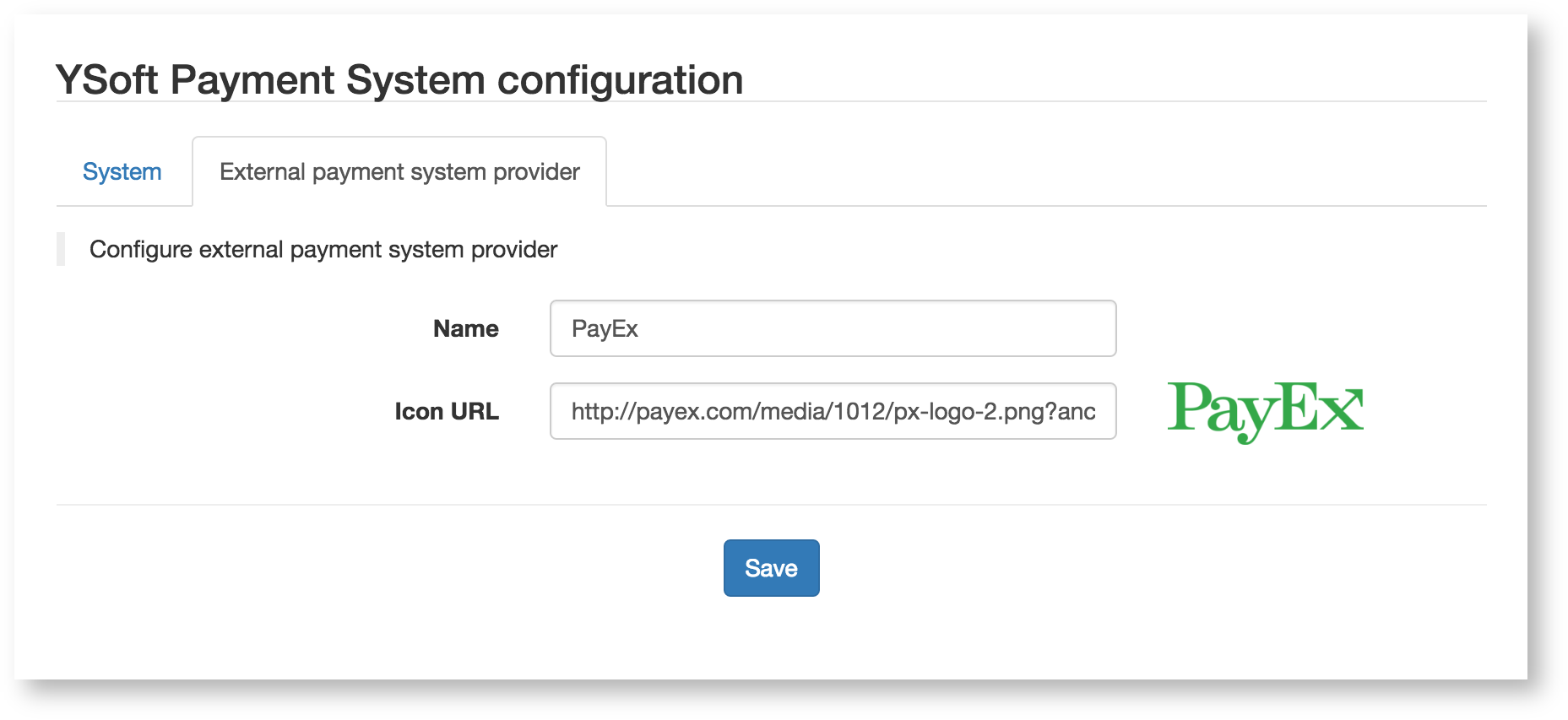Configuring YSoft SafeQ end user interface
This page contains YSoft SafeQ end user interface documentation for administrators.
Installation
YSoft SafeQ end user interface is installed automatically, no configuration is necessary.
YSoft SafeQ end user interface installer will create:
Windows service YSoft SafeQ end user interface
Web interface accessible via default URL https://<SPOC_HOST>:9443/end-user/ui
Default installation directory in <install_dir>\SPOC\EUI\
Enable YSoft SafeQ end user interface features
If you want to use all of the YSoft SafeQ end user interface features, you have to configure YSoft SafeQ Payment System and YSoft SafeQ Mobile Print Server in the YSoft SafeQ management interface. Payment gateways need to be configured in YSoft SafeQ Payment System.
YSoft SafeQ Payment System
Install and enable YSoft Payment System in the YSoft SafeQ management interface by setting the Enable YSoft Payment System configuration option (property name: enablePaymentSystem) to enabled.
When Enable YSoft Payment System option is disabled, Payment menu item, My deposit widget and user's balance are not visible in the YSoft SafeQ end user interface.
YSoft SafeQ Mobile Print Server
Install and enable YSoft SafeQ Mobile Print Server in the YSoft SafeQ management interface by setting the Enable Mobile Print Server option ( Property name: enableMobilePrintServer ) to enabled.
When Enable Mobile Print Server option is disabled, Upload job menu item is not visible and users are not able to upload jobs via the YSoft SafeQ end user interface web.
Processing of uploaded jobs
Files uploaded to the YSoft SafeQ end user interface are further processed by other subsystems. Here is a rough description of the process:
Files are physically saved into a hot folder on the YSoft SafeQ end user interface server. Its default location is <install_dir>SPOC\server\mobile.
Files are processed by YSoft SafeQ Mobile Print Server and removed from the hot folder.
Data are sent to YSoft SafeQ FlexiSpooler (mode for server spooling).
YSoft SafeQ FlexiSpooler saves jobs data into folder <FLEXI_SPOOLER_HOME>\Service\JobStore\controller-<ID>\
Job metadata are sent to YSoft SafeQ Spooler Controller and YSoft Management.
Changing the hot folder
The path to the hot folder depends on the configuration of YSoft SafeQ, YSoft SafeQ end user interface and YSoft SafeQ Mobile Print Server. You can change the path to the hot folder by the following steps.
Change YSoft SafeQ system setting "Mobile Print Server spool directory" (alias mpsSpoolDir).
Change the YSoft SafeQ end user interface configuration "spoc.homeDirectory". See section Advanced configuration for more detail.
Change the YSoft SafeQ Mobile Print Server configuration "folderSources".
Here is example of final path "%safeq_home_directory%/server/mobile/" (home directory will be replaced by the value of "spoc.homeDirectory").
Payment gateways
Configure at least one payment gateway connector in YSoft SafeQ Payment System (Electronic payment tab). After configuration, the users are able to use Payment gateways in the YSoft SafeQ end user interface.
Supported payment gateways are:
PayPal
DIBS
Account connection
If you use an external payment system provider which needs a user's permission to access their account, the administrator needs to set up the provider's name and logo URL in YSoft SafeQ Payment System administration. This name and logo are used in the YSoft SafeQ end user interface in the Account connection menu.

Advanced configuration
If the YSoft SafeQ end user interface is deployed on the same server as YSoft SafeQ Spooler Controler (SPOC), no configuration is needed, everything is preconfigured.
Configuration of YSoft SafeQ end user interface can be edited or added into environment-configuration.properties file located in <install_dir>\SPOC\EUI\ui-conf\
The following parameters are editable:
Element(s) | Description |
restClient.yps.maxTotalConnections | Maximum number of simultaneous connections to YSoft SafeQ Payment System. The default value is 200. |
web.channel | Determines channel used by the web of YSoft SafeQ end user interface. The default value is https. Valid values are http, https or any. Value https will force redirect from http to https channel. |
web.http.port | Port for http channel. The default value is 9090. |
web.https.port | Port for https channel. The default value is 9443. |
safeq.authentication.address | Address for communication with YSoft SafeQ. Default value is "tcp://127.0.0.1:5555". |
spoc.homeDirectory | Path to the home directory of YSoft SafeQ Spooler Controler. This option is used for determining the hot folder location. The default value is "../..", which usually means <install_dir>\SPOC. |
remoteService.callDurationThresholdInMillis | The threshold for calls to remote systems (YSoft SafeQ Payment System and YSoft SafeQ 6). When calls take longer a warning will be logged. Value is in milliseconds. The default value is 1000. |
See also file C:\<install_dir>\SPOC\EUI \webapps\end-user\WEB-INF\classes\defaults.properties for all properties that can be customized in environment-configuration.properties file for a particular end user interface instance.
Customizable Error pages
Error pages can be customized for errors 403 Forbidden, 404 Not Found, and 500 Internal Server Error. It is possible to change an image, page title (text in the browser's tab), header, and error description.
If you want to know, where to configure customizable error pages, see section Advanced configuration.
Beware special characters and encoding. Properties files are by default encoded in ISO-8859-1. To convert special characters, use for example this tool.
Element | Description |
error.image
| Image to be displayed on the error page - it can be anything, you just have to specify a folder of the image. Supported image files are: JPG, PNG, GIF and BMP. |
error.XXX.title
error.XXX.header
error.XXX.description
| Title, header, and description of the error page (XXX stands for the required error code - 403, 404, or 500) |
Example of custom error pages:
##############################################################################################
# Error pages
##############################################################################################
#full path to custom image on error pages
error.image=C:/Users/administrator/Documents/EUI/src/main/resources/custom.png
#custom title, header and description for individual errors
error.403.title=Forbidden
error.403.header=Woops!
error.403.description=403 error
error.404.title=Not found
error.404.header=Woops!
error.404.description=You are looking where you shouldn't.
error.500.title=Internal Server Error
error.500.header=Woops!
error.500.description=Something went wrong.